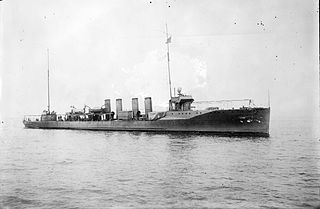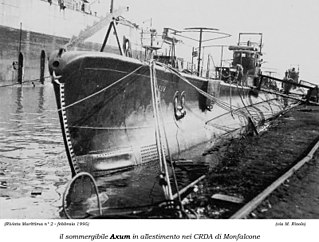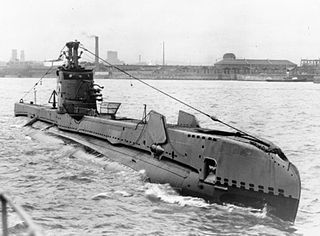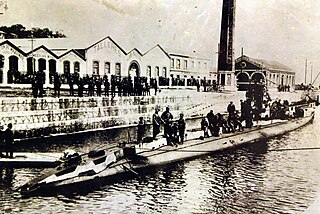
USS Wainwright was a Tucker-class destroyer built for the United States Navy prior to the American entry into World War I. The ship was the first U.S. Navy vessel named in honor of U.S. Navy officers Jonathan Wainwright, his cousin, Commander Richard Wainwright, and his son, Jonathan Wainwright, Jr..

Italian submarine Axum was an Adua-class submarine built in the 1930s, serving in the Regia Marina during World War II. She was named after an ancient city of Axum in Ethiopia.

I-58 was a Japanese B3 type cruiser submarine that served in the final year of World War II. Her only significant wartime success came with a conventional torpedo attack upon USS Indianapolis on 30 July 1945. She was modified to carry Kaiten manned torpedoes, making several attacks that inflicted minor damage in exchange for every Kaiten launched being sunk. The submarine surrendered in September 1945, and was later scuttled by the United States Navy.

HMS Safari was a third batch S-class submarine built for the Royal Navy during World War II. Commissioned in 1942, she was assigned to operate in the Mediterranean Sea. During the course of the war, Safari sank twenty-five ships, most of which were Italian.

German submarine U-521 was a Type IXC U-boat of Nazi Germany's Kriegsmarine during World War II.
German submarine U-353 was a Type VIIC U-boat of Nazi Germany's Kriegsmarine during World War II. The submarine was laid down on 30 March 1940 at the Flensburger Schiffbau-Gesellschaft yard at Flensburg, launched on 11 November 1941, and commissioned on 31 March 1942 under the command of Oberleutnant zur See Wolfgang Römer. After training with the 5th U-boat Flotilla based at Kiel, U-353 was transferred to the 1st U-boat Flotilla at Brest in France for front-line service from 1 October 1942.

HMS Sickle was a third-batch S-class submarine built for the Royal Navy during World War II. Completed in 1942, she made her initial war patrol off the Norwegian coast. Sickle then sailed to Gibraltar, from where she conducted one patrol, then to Algiers, French North Africa. From 10 May to 10 October, the boat patrolled the Gulf of Genoa five times and sank a German submarine as well as three minesweepers and an escort ship. She then moved to Beirut, French Lebanon, and conducted two patrols in the Aegean Sea, sinking three caïques and a merchant ship, in addition to landing resistance operatives in Greece.

HMS Saracen was a third-batch S-class submarine built for the Royal Navy during the Second World War. Completed in 1942, Saracen conducted a patrol in the North Sea where she sank a German U-boat. She was then assigned to the 10th Submarine Flotilla in Malta, from where she made three patrols; on her second, she sank an Italian submarine. Saracen was then reassigned to the 8th Submarine Flotilla, based in Algiers, French North Africa.

HMS Sportsman was a third-batch S-class submarine built for the Royal Navy during World War II. Completed in 1942, she spent most of the war serving in the Mediterranean Sea. After an initial patrol off Norway, she sank the heavy transport Général Bonaparte in the Mediterranean in 1943 and missed a French oil tanker. She was heavily damaged after a mistaken attack by an Allied bomber, and was sent east after repairs to participate in operations in the Black Sea. After the operation was cancelled, Sportsman patrolled the Aegean Sea, sending several Greek and German ships to the bottom. She sank the German transport SS Petrella in early 1944 despite it being clearly marked as a prisoner-of-war ship, killing 2,670 out of 3,173 Italians aboard. Sportsman sank several more ships, and suffered minor damage when she was detected and sighted while attempting to attack a convoy.

HMS P222 was a third-batch S-class submarine built for the Royal Navy during World War II. Commissioned in 1942, the boat had an uneventful first war patrol in the Alboran Sea. She intercepted the Vichy French merchant ship SS Mitidja in July, then provided protection for an Allied convoy to Malta in Operation Pedestal the next month. The navy intended that she was to be sighted on the surface by enemy aircraft to discourage potential attacks by surface warships. Though P222 did not encounter enemy forces, the convoy arrived at its destination on 15 August after sustaining severe losses. She then reconnoitred along the coast of Algeria in advance of Operation Torch, and was attacked by a French patrol ship, but sustained no damage.

USS Wakiva II (SP-160), often referred to as USS Wakiva, was an armed yacht that served in the United States Navy from 1917 to 1918 and saw combat in World War I. She was originally the yacht SS Wakiva II built for Lamon V. Harkness in Scotland.
SM UB-32 was a German Type UB II submarine or U-boat in the German Imperial Navy during World War I. The U-boat was ordered on 22 July 1915 and launched on 4 December 1915. She was commissioned into the German Imperial Navy on 11 April 1916 as SM UB-32.
SM UC-38 was a German Type UC II minelaying submarine or U-boat in the German Imperial Navy during World War I. The U-boat was ordered on 20 November 1915 and was launched on 25 June 1916. She was commissioned into the German Imperial Navy on 26 October 1916 as SM UC-38. UC 38 was a successful commerce raider, operating throughout her career in the Mediterranean theatre. In nine patrols UC-38 was credited with sinking 43 ships, either by torpedo or by mines laid. She was sunk in December 1917 in an action off Cape Ducato, Greece, during which she torpedoed the French cruiser Chateaurenault.

SM UC-56 was a German Type UC II minelaying submarine or U-boat in the German Imperial Navy during World War I. The U-boat was ordered on 12 January 1916, laid down on 4 March 1916, and was launched on 26 August 1916. She was commissioned into the German Imperial Navy on 18 December 1916 as SM UC-56. In six patrols UC-56 was credited with sinking one ship by torpedo: the British hospital ship HMHS Glenart Castle. UC-56 suffered from mechanical breakdowns that prevented her from submerging. She put in at Santander, Spain, on 24 May 1918 and was interned there for the duration of the war.

United States Navy operations during World War I began on April 6, 1917, after the formal declaration of war on the German Empire. The American navy focused on countering enemy U-boats in the Atlantic Ocean and the Mediterranean Sea, while convoying men and supplies to France and Italy. Because of United States' late entry into the war, her capital ships never engaged the German fleet, and few decisive submarine actions occurred.

USS Venetia (SP-431) was a large 589 gross ton steam yacht leased by the U.S. Navy during World War I. She was heavily armed with four 3-inch (76 mm) guns and depth charges, and was assigned duties of a patrol craft, escorting ships in convoy on the North Atlantic Ocean, and protecting those ships from German submarine attack. Venetia was awarded a "star of reward" for her antisubmarine work, and mounted the star on her stack. Post-war she was restored to her original civilian configuration, and was returned to her owner.
I-72, later I-172, was a Kaidai-class cruiser submarine of the KD6 sub-class built for the Imperial Japanese Navy (IJN) during the 1930s. She served in the early months of World War II, supporting the attack on Pearl Harbor, patrolling in Hawaiian waters in early 1942, and taking part in the Guadalcanal campaign before she was sunk in November 1942.

Ro-50 was an Imperial Japanese Navy Kaichū type submarine of the K6 sub-class. Completed and commissioned in July 1944, she served in World War II, conducting four war patrols, including operations off the Philippine Islands and the Ryukyu Islands. The only Kaichu-type submarine to survive the war, she surrendered in 1945 after its conclusion and was scuttled in 1946.

Ro-101 was an Imperial Japanese Navy Ro-100-class submarine. Completed and commissioned in October 1942, she served in World War II and operated in the Solomon Islands and the New Guinea area until she was sunk in September 1943 during her eighth war patrol.
Ro-111 was an Imperial Japanese Navy Ro-100-class submarine. Completed and commissioned in July 1943, she served in World War II, operating in the Indian Ocean — where she sank a cargo ship and a troopship — and off the Admiralty Islands in the Pacific Ocean. She was sunk in June 1944 during her fifth war patrol.

















